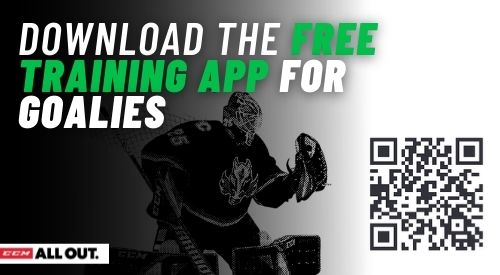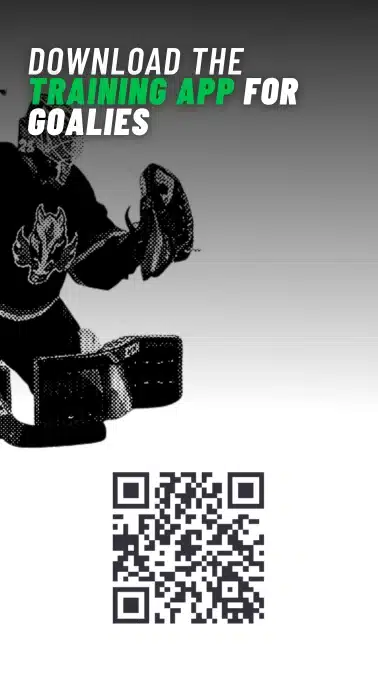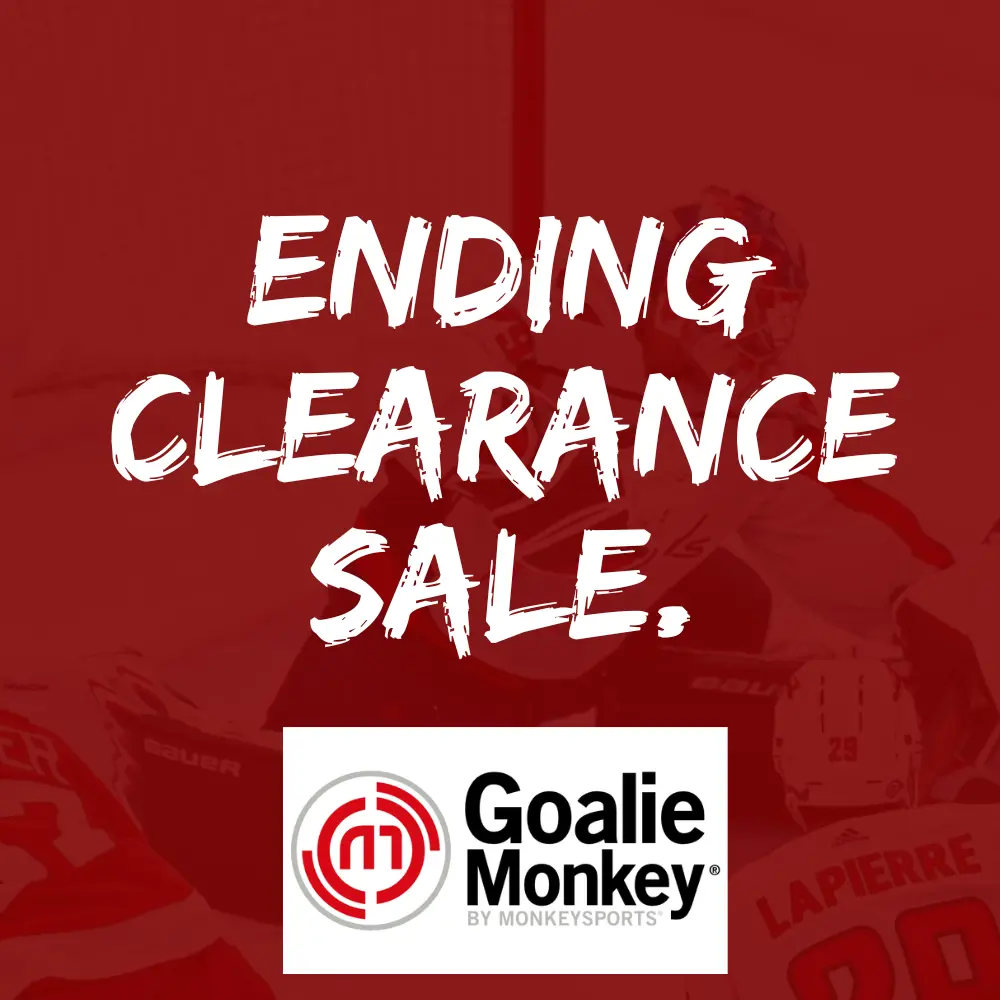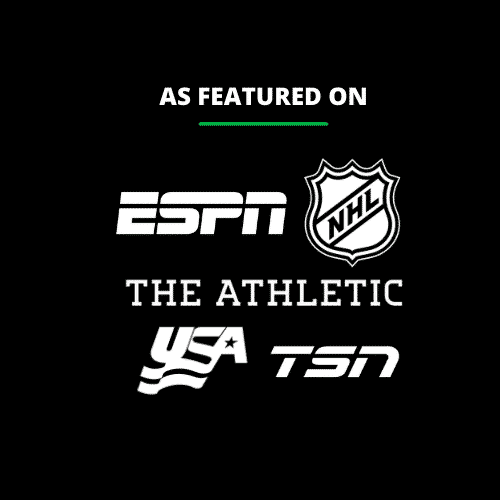Dedicating yourself to becoming a better hockey goalie is a lifelong task that does not happen overnight. It’s a long endeavor that takes hundreds of hours, especially if you want to play in the NHL. In reality, your odds of becoming an NHL goalie are extremely low, let’s just face it – there are only 32 NHL teams in the world. That means, at any given time there are roughly 64 goalies in the National Hockey League.
Now, just because the odds are low, does not mean you shouldn’t try. Learning how to be a better hockey goalie will help you at any level of play, whether you’re in Squirts or playing Junior Hockey. If you’re still in K-12 school, your odds of playing Junior Hockey are still relatively high, with hundreds of Junior Hockey teams in North America, there are plenty of opportunities to continue your playing career beyond school. As I like to tell our clients, preparing yourself to step through the next door, whether it’s onto your High School team or a Junior Team, is in the realm of your control. You are entirely capable of doing the necessary work it takes to become a better goalie enabling yourself the opportunity to continue play beyond your current level.
Giving yourself the opportunity to become a better hockey goalie involves two main factors. First off, your work ethic. Now, this goes without saying. To become a better goalie you’ve got to have the desire to work on your craft. The second factor is more vauge, this is an understanding of the goaltender position and knowing what to learn and how to identify weaknesses in your game. For the sake of this article, we’re going to focus on the educational element of becoming a better goalie.
Put a goalie coach in your pocket with the Goalie Coaches training app, built specifically for hockey goalies. The Goalie Coaches app has been used at every level of play, up to the NHL. Unlock hundreds of drills, game specific scenarios, and more inside the free app, today.
12 Things You Need To Understand To Become A Better Goalie
Whenever somebody asks me how they can become better at being a goalie, I typically ask them how much time they’ve got. This is not something that can easily be answered in a quick 5 minute conversation. It’s also not something that is definitive, because every single goalie in the world is on a different developmental path and is likely playing at a different level than their peers.
To make this complex subject easier to understand, it can be broken down into what I call the “Laws of Becoming An Elite Goalie”. Reader beware, this is not an end all be all. Following this guide will not guarantee your success, because no one other than yourself can determine how hard you will work at this. Developing a thorough understanding of how and what to learn and actually applying it will make far more difference than simply studying more and watching more video. This guide is focused on practical, on and off ice behavior designed to help you improve as a goalie immediately. While I did not include goalie mindset training in here as it’s a far more advanced topic, we have discussed it at length in the linked article.
These 12 development concepts will help you become a better goalie today.
- A Save Is A Save
- Prioritizing Seeing The Puck
- Learn The Guarantees And Excel at them
- How You Can Minimize Risk To Be A Better Goalie Overnight
- Developing Efficient Explosiveness
- Improving Your Rebound Control
- Become Aware Of Where You Are In The Crease
- Learning How To Learn
- Building Your Own Goalie Training Plan
- Better Goalies Understand How Critical Consistency Is
- Maximizing Your Time On The Ice
- Advanced Concepts of Elite Goalies
In reality, this article could be 20,000 words long. In an effort to deliver this information in less than that, we’ve boiled it down to the 12 of the most important factors in becoming a better goalie. At the professional level, these are arguably the most important components of goaltending that every single NHL goalie possesses. While there are countless factors and methods to becoming a better goalie, if you can understand these and learn how to apply them to your own individual game, you will change how you play the position for the better, thus, improving overnight.
A Save Is A Save
The number one rule in goaltending is that saving the puck is more important than anything else you’ll do on the ice. If you take the position of goaltending and throw every single thing you read, watch, or hear out the window, the single most important thing you’ll ever do on the ice is making the save.
Whether you make a diving save, a perfect butterfly save, or scramble around in the RVH before making your save, if you’ve done prevented the puck from entering the net you have done your job correctly. Now, when you make a save incorrectly and give up a rebound that results in a goal, this is obviously incorrect. It’s whether or not you’re able to analyze what went wrong and how you can improve it for next time that will ultimately dictate whether or not you’ll be able to improve as a goalie.
What should I learn from this?
This means, that no matter the fancy skating technique, no matter the way you see your favorite NHL goalie making a save, if you stop the puck you have done your job correctly. Plain and simple, there is no right or wrong way to stop the puck. Now, in the next point, “Seeing The Puck”, you’ll begin to see the thought process we use to moving in the crease, which will help to enhance your ability to make said save.
While learning to be a better skater will help you as a goalie, a goalie who is technically sound in every component of his or her skating game but fails to stop the puck simply will not see the ice. They will also struggle to advance to the next level of play. This does not mean that skating ability isn’t important, it is. It’s one of the most important parts of being a great goalie, which leads into the next aspect of elite goaltending.
Prioritizing Seeing The Puck
Developing your skating ability as a goalie will help you see the puck better.
Wait, how does becoming a great skater help me see the puck better? This point should really be broken into a sub-argument that talks about movement while seeing the puck vs. standing still while seeing the puck, but for the sake of brevity we can cover both here.
Beyond making the actual save itself, all of the movement that leads up to the actual part of making the save is skating ability, threat recognition and awareness, and ultimately save selection prior to making the save. Now, it’s very easy to beat a dead horse on which technique you should use to make saves as a goalie. For 99% of goalies simply trying to become better in the crease, the focus should be on how you can prioritize seeing the puck.
And this doesn’t simply mean just having better vision of the puck. When we talk about “seeing the puck”, what we’re talking about is whether or not you are moving while seeing the puck. A critical element to maximizing hand eye coordination is being still when tracking the puck towards your body in preparation to make the save.
The best way to visualize this is if I gave you a baseball glove and proceeded to throw a baseball at your face while you are standing still. Would it be easier to catch this baseball if you were running while I threw that baseball, or while standing still?
If you haven’t picked up where I’m going with this, the answer is that it is easier to catch this baseball while you are standing in once place. Now, this doesn’t mean that as a goalie you should make every save standing perfectly still. There are hundreds of scenarios that dictate movement while making a save.
Examples of this include passes across the slot, breakaway scenarios, rebounds, etc. When you can control it, you should put yourself in a position to see the puck from the actual shot, into your body, without having to move laterally or forward / backward as this is happening.
How is this accomplished? By reading scenarios and having an adept skating ability that allows you to get to your position in the crease prior to the shot happening. How do I improve this? By becoming a better skater.
Speaking of developing your skating ability. If I had a dollar for every time I was asked how goalies can become better skaters, I’d be retired sitting on a beach in the tropics right now, not writing this. When it comes to skating, there are very few skating drills that will actually make you a worse skater as a goalie. That means, just do it. If you can’t think of a skating drill, make something up on the fly. Pick a sequence of movements that you watched in an NHL highlight video, or have done in a game. It could even be a certain scenario in which you were scored on! Rinse, repeat. I can guarantee you, you cannot do this enough.
Becoming a better skater will help you see the puck better, because you will be able to put yourself in position faster than you were before. There is no denying that your eyes process information better when the rest of the body is still. If we throw out making the actual save itself (which, doesn’t really count, everybody knows making the save will make you a better goalie), seeing the puck is the single most important thing you can do.
What should I learn from this?
Becoming a better skater in the crease will help you see the puck better because you will be in position to make the actual save faster. Each time you step onto the ice, you should find time to work on your skating ability. Do this with a purpose, knowing that by becoming a better skater you will allow yourself the opportunity to be in position quicker and allow yourself more time to see the actual puck itself.
Learn The Guarantees And Excel At Them
There are few guarantees in goaltending. One of the worst is that you will be scored on. The best goalies in the world are scored on most of the time they take the ice for a game. This is reflected in their Goals Against Average and Save Percentage.
When we talk about guarantees, we should really talk about things you can control. There are two things that goalies can have 100% control over, these being their attitude and work ethic. Obviously, that wouldn’t make for a very interesting article, but it’s worth mentioning. The best goalies in the world have learned to channel their focus into a truly elite work ethic and attitude. If you have a bad attitude, your work ethic is also very likely to be poor. Put simply, your odds of becoming an elite goalie are fairly slim.
Alright, so if we can’t talk about work ethic and attitude, the two things that the best goalies possess at a very high level, then what are the other guarantees?
If you’ve read ahead on this list, you likely realized that rebound control wasn’t at the top of it. There’s a reason for it. Rebound control isn’t something you can improve overnight. While developing better rebound control will absolutely make you a better goalie, there’s something that is far more important than that.
The answer, learning the guarantees and excelling at them. Specifically, catching pucks and learning to use your stick effectively.
What’s better than having great rebound control?
Not giving up rebounds. You knew I was going to write that. Of course, reducing rebounds by 100% is simply not possible, it is possible to excel at catching pucks. It is possible to redirect a very high percentage of shots on the ice out of high danger areas with your stick.
Catch Pucks Shot At Your Glove
Pucks shot at the goalies glove and pucks shot on the ice, if you are positioned well in the crease, are very easy situations in which you can control your lack of rebounds. If you are struggling with your rebound control, I challenge you to dedicate yourself to catching pucks better and positioning your stick better so that you can take these two very high percentage saves and truly excel at them.
Improving your angles and squareness is a basic foundation of goaltending. Without learning how to properly position yourself in the crease, everything else about the position becomes increasingly difficult.
The best goalies in the world have no problem making stick saves or glove saves. This is because they have dedicated years to developing both abilities. If a puck is shot at the glove, you should be able to catch it every single time. The glove is the one piece of equipment goalies have where the entire purpose of it’s design is for the puck to not bounce off quickly.
Goalies playing in the NHL have a higher puck catching area than those who are not.
Goalies who are average at catching the puck will give up a higher percentage of rebounds than those are who not. This not only leads to goals that “you’d like to have back”, but to a higher percentage of rebound scenarios. So what do elite goalies do that average goalies do not?
The first thing, is that when pucks are shot into an area that makes them catchable, they catch and hold the puck. This puts them in control of a guaranteed scenario. They can stop play if they choose, or they can place the puck on the ice to continue play. The second thing that better goalies do is they expand their puck catching area.
This means, they are capable of increasing their guaranteed control zone beyond that of an average goalie, who can only catch pucks in a much smaller area. If you want to become better as a goalie, it means giving up less goals over a long period of time. With the glove hand being one of the few guaranteed areas in which you can make a save an reduce rebounds, the only way to get more of it is to expand the area in which you catch pucks.
This is very simple, not re-inventing the wheel, just catch more pucks in front of you. If you have the opportunity to catch the puck in the middle of your body, do it! Your glove is better at controlling rebounds than your chest protector. If you can learn to catch low pucks shot from a distance, even better. Your pads are designed to create rebounds. Now, they should kick these rebounds out of high percentage scoring areas, but as we know it does not always work that way.

Learn to catch pucks in front of your body.
Without spending this entire article on catching pucks, one other point that’s worth mentioning is catching pucks in front of your body. Back to the baseball scenario, I work with far to many goalies who catch pucks at the side of their body versus in front of their body. If I were to throw a baseball at your head, odds are you’d catch it in front of your head.
If you have time to make a glove save in which you watch the puck all the way into your glove, you most likely have time to catch the puck in front of your body. The study of why this is better is often referred to as “Head Trajectory”, but that’s an article for later.
What it comes down to is taken from the point above, “Prioritizing Seeing The Puck”. When your head starts to move to the side, your eyes are also in motion. This makes it physically harder to gauge where the puck actually is, thus reducing the chances of making an effective glove save. If you can learn to take control of glove saves by making these saves in front of your body, you’ll make it physically easier on your eyes and brain, increasing the percentage in which you actually make this type of save effectively.
The concept of developing a better glove as a goalie is a far more in depth subject than we can cover here, so we’ve written about it on the linked article.
Take Advantage Of Low Shots With Elite Stick Work
As a result of simply playing the position, you will develop all aspects of your game. For the sake of ranking it’s importance as one of the guarantees that you can control in the crease, I list it as the second most important thing, because stick saves are anything but guaranteed (even for the games best goalies). It’s also not as easy to train for better stick saves as it is to train for catching pucks better.
Improving your stick save ability is something that you should never stop training. This is also one of the things that most goalies who are average fail to ever develop. If you’re constantly breaking goalie sticks in the heel area, it’s not the stick, it’s you. You’re making to many stick saves with the stick to close to your pads and no matter the material, your still will eventually begin to break down.
Similar to how better goalies posses a wider puck catching zone, they also have an increased area in which they control low shots with their stick. There are two things you can do to improve your stick saves.
- Understand how you should position your stick. This is covered in depth in our better stick saves article, but the answer is a bit further out than you’re currently placing it.
- Increase the area in which you can make stick saves. NHL goalies can make stick saves at the toes of their pads just as easily as they can when it’s shot right in the five hole area.
Shots in areas that you can control effectively with your stick should be controlled with the stick. Goalie sticks are the only piece of equipment that can easily take a shot an put it out of play into the netting behind you.
How You Can Minimize Risk To Be A Better Goalie Overnight
I cannot tell you how many youth goalies I’ve spoken with over the years who have struggled with passes to the slot area, or passes from high to low. Let me tell you a little secret, as you get older, this only gets worse. It gets worse, because your competition gets better. In the NHL, a very high percentage of goals that happen cross an area called “The Royal Road“.
Developing Efficient Explosiveness
Efficient explosiveness simply means not over moving in the crease. One goalie who I believe is proficient at this is Joey Daccord. The way Daccord moves in the crease is highly efficient and as a result, he is rarely out of position. When he is, his recoveries to the next position are explosive, but rarely so explosive that he takes himself out of the next play.
Of course, every goalie at the NHL level maintains the ability to be explosive. Being efficient with your movement involves a deeper understanding of being square and on angle. This includes things such as the Angle Before Depth Concept. We’ve written about that extensively in the linked article, so without over-doing it here let’s outline this with a graphic.
In the illustration below, we’ve outlined a pass across scenario from Player A to Player B. If the goalie begins his movement at “X”, the blue line indicates the movement they would have to take to get “on angle” if they chose to get their angle before their depth. The pink line in the illustration shows the goalies movement if they tried to get their angle and their depth at the same time.
As you can clearly see, gaining the angle prior to gaining depth is a shorter distance traveled. Learning how to move about the crease in this way, when the situation dictates, can buy you critical time allowing you the ability to see the puck longer. This will in turn enhance your ability to make the save.
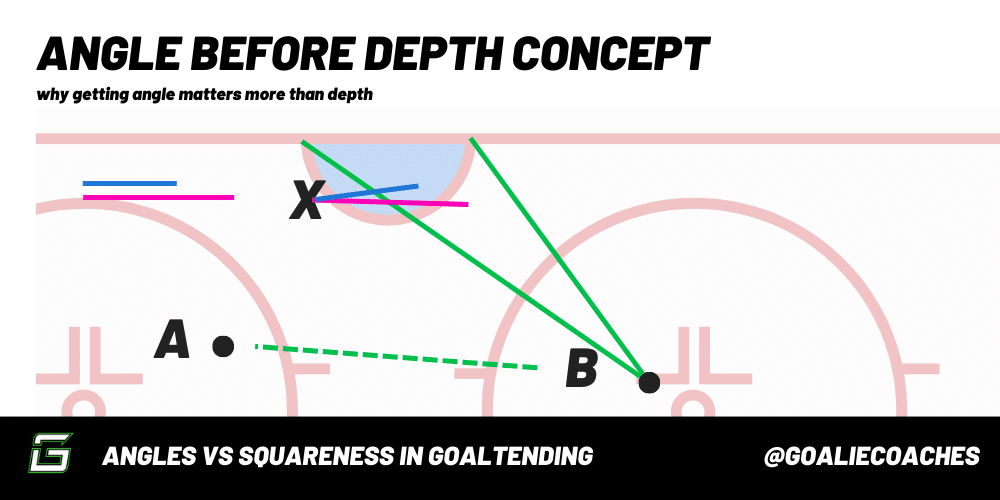
Improving Your Rebound Control
You’d think in writing this that rebound control would’ve been at the top of the list, but it’s not. That doesn’t mean it’s any less important. A huge amount of goals are scored every day from rebound scenarios. Getting better at rebound control involves learning save selection, how you play certain scenarios, when you hold your feet and when you go down, how to recover properly, and so much more.
Rebound control is one of those elements of goaltending that is truly a lifelong endeavor, making it so much harder to train overnight. This is also why it’s listed near the bottom of our list here.
Starting to improve rebound control starts with learning to give up less rebounds from the start.
There are ultimately 5 types of saves that happen every time a goalie makes a save.
- A glove save
- A blocker save
- A save off of the chest protector
- A stick save
- A pad save
Of these 5 types of saves, by improving our stick save ability and our glove save ability, we can reduce the amount of times we have to rely on our pads and our chest protector to make saves. This is why it is so critical to develop these two components of your game first, before you dive into advanced save selection and simple reaction ability.
Because so much of the goaltending position is reaction and recoveries from these reactions, developing total rebound control is nearly impossible. Learning to smother pucks can provide a huge advantage to you as a goalie, as these are times when you may not have had the opportunity to mitigate any rebound risk.
Learning to be better at rebound control is as much about what you do when you’ve given up a rebound as it is properly distributing this rebound into a low danger area. Developing a thorough understanding of Box Control can ultimately help you understand which type of save to make, but it will not eliminate your rebound control problem overnight.
Simply put, that’s why it’s important to control the things you do have complete control over, limiting the amount of times you create unsatisfactory rebound scenarios. This point cannot be stressed enough. Goalies who come to us with a rebound problem, they have a puck watching problem. They react slower than they should, which creates pucks bouncing off of pads, not knowing where pucks are, and as a result they beat themselves.
Start to become better at rebound control by improving your puck tracking ability, you’ll see an improvement virtually overnight.
Become Aware Of Where You Are In The Crease
A mis-understanding of where you are in the crease leads to a massive amount of goals for beginner goalies. If you’re a total beginner, this is one of the first things you need to understand. Where should I be located on zone entries? Where should I stand when pucks are in the corner? Should I be in the RVH?
Crease awareness and over compensation for poor positioning in the crease creates many unsatisfactory scenarios for the first time goaltender. To develop crease awareness, you must spend more time on the ice in games and in practice. Of course, this isn’t the answer you’re likely looking for but there is no denying repetition when it comes to getting better.
Post Play Positioning
One thing I challenge beginner goalies to develop when they are learning where they should be located in the crease is post play. Many goalies create poor positioning for themselves while they are on the post, a position in which you’ll spend plenty of time in as a goalie. Should you step off of the post to make a save from an off angle? Should you make this save while your foot is still on the post?
Practicing both of these scenarios will help you develop a good understanding for what is most comfortable to you. Certain goalie drills that force you to step out from the post for a shot, making a save to the corner, and then facing a backside wrap around can also help you understand the risks of stepping off the post.
Learning a playing style that is repeatable will allow you to train better, helping you become more prepared so that when scenarios develop, you can execute your movements without thinking. This is the ultimate sign of a well rounded goaltender.
When I think about situational goaltending that can change depending on the side of the ice you are playing, there are two scenarios that come to mind. Both involve the RVH.
Scenario #1: utilizing the RVH on goal line attacks when the puck is on your blocker side.
For most goalies, this is the right side of the rink as you’re standing in your crease. An example of this is shown below.
Learning How To Learn
Learning how to learn is critical to becoming better at anything, yet it’s a huge issue for much of today’s youth. Spending time watching goalie highlights may make you a better goalie in the long run, but only if you know how to apply the information you’re taking in. On top of that, highlights are highlights for a reason, the goalie in them often times had to make a spectacular save because they were out of position just prior.
Stop right there. Because they were out of position before.
What happened just prior to this amazing save? Is there something to be learned from it? While a large percentage of goals scored in the professional game are simply due to the world class skill level of todays players, there is often something to be learned from analyzing the entire play.
Learning how to learn from watching game recaps is an excellent place to start. It’s a way to unlock more enjoyment in your training and it forces you to think critically about how certain scenarios develop. If you can do this, you’re off to the right start.
Start recording your practices and games to find problem areas you need to improve at.
This doesn’t mean you need a personal film crew on the ice with you at all times. When you have the opportunity, gather film of yourself. Compare this film against where you think you are to unlock critical areas of development that you must focus on.
Common problem areas that are quickly identified include:
- Stick positioning
- Stance
- Overly aggressive crease positioning
- Sliding out of position
- Overuse of certain techniques, like the RVH
- Giving up your feet too quickly
- Losing sight of the puck behind the net
Of this list, there are hundreds of additional issues that can be identified through self analyzing your own film. While it’s common practice to try rebuilding Rome overnight, remember that focusing on to much all at once puts you in the category of “Jack of all trades, master of none”.
Your time on the ice at the next practice is limited, working on 10 things for 1 minute is worse than working on 1 thing for 10 minutes. Pick a few problem areas in your game and dedicate the next number of practices to them until you feel confident you’ve gotten better at this specific area of play.
Building Your Own Training Plan
One of the single most critical things that must take place if you’re serious about improving as a goalie is committing to a training plan. This doesn’t mean that you have to go out and buy some expensive training program, or hire the best goalie coach on the planet.
What this does mean is that you should analyze your game critically, identify the areas of weakness that you currently have, and commit yourself to working on them.
There is always time to work on becoming a better goalie, whether it’s maximizing your opportunities on the ice, or focusing on certain elements of off ice improvement. We’ve covered this extensively in our “How To Train A Goalie” guide, so diving into everything here isn’t neccesary.
Want help with training ideas? We’ve built an app designed to be a goalie coach in your pocket. Take a look!
Put a goalie coach in your pocket with the Goalie Coaches training app, built specifically for hockey goalies. The Goalie Coaches app has been used at every level of play, up to the NHL. Unlock hundreds of drills, game specific scenarios, and more inside the free app, today.

